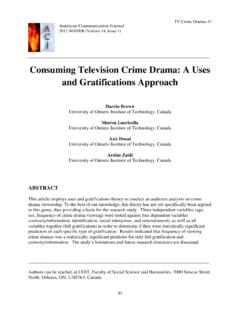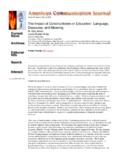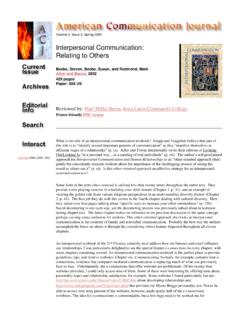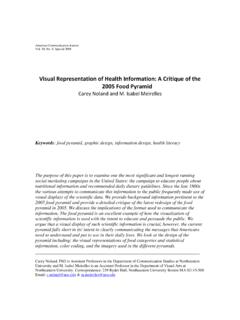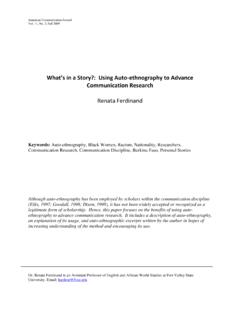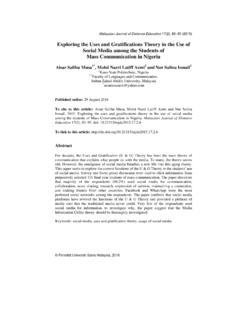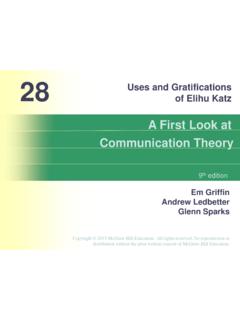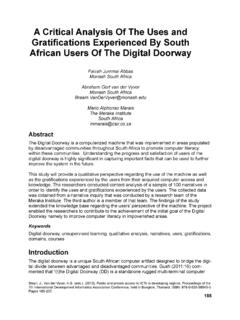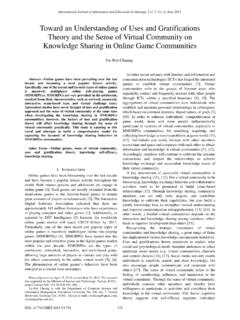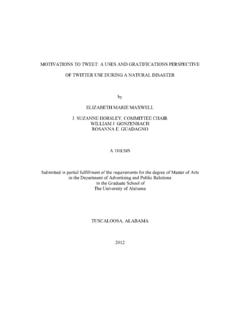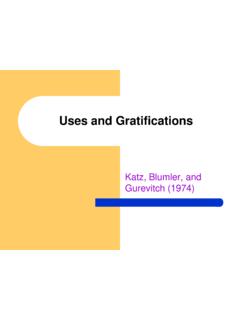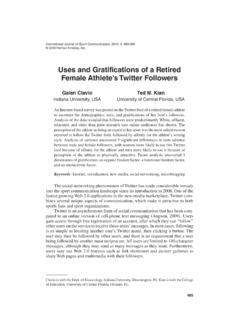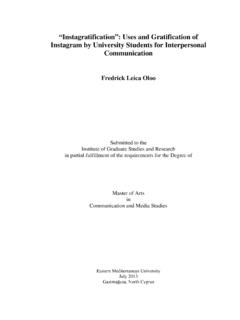Transcription of Integrating Uses and Gratifications with the Theory of ...
1 59. American Communication Journal 2013 SUMMER (Volume 15, Issue 3). _____. Integrating uses and Gratifications with the Theory of Planned Behavior to Explain Political Disaffection and Engagement Rebecca M. L. Curnalia Youngstown State University Dorian Mermer Youngstown State Universoty ABSTRACT. The Theory of planned behavior (TPB) suggests that attitudes, norms, and efficacy predict behavior. uses and Gratifications (U&G) asserts that motives predict media use. When looking at the conceptualization of attitudes and norms in the TPB and motives in U&G, the two are conceptually similar and both appear to be a robust starting point for understanding political engagement. This paper reports the results of a study where motives and TPB variables were used to explain differences in political behaviors, like time spent using political news, following politics in diverse media outlets, voting, and engaging in other political activities.
2 The results help explain the age-related differences in political engagement that have been observed in previous research. KEYWORDS: voting, political news, uses and Gratifications , Theory of planned behavior, age _____. Contact Information: Direct correspondence to the first author, whom can be reached via email at 60. I. Introduction People who believe that their vote will not make a difference, that they are too busy to vote, that it is difficult to get to the polls, and that politics are unimportant are unlikely to vote (Pew, 2006). The people who hold these beliefs also tend to be younger, less wealthy, and less educated compared to people who regularly vote. These are also, demographically, the people who are least likely to follow the news (Pew, 2010a). Of those ranging in age from 18 and 29, 40% are not registered to vote and 25% are registered but rarely vote. News use has also steadily declined among this age group.
3 So there is a disengaged, disaffected group of Americans who are not participating in the political process in the United States. By exploring the reasons for using and avoiding political news, researchers may be able to discover ways to help keep people informed. Further, by looking at predictors of political activity, researchers and practitioners may also find new ways to get people involved in politics. Two theories may help explain disparities in political activity in general and political news use in particular: The Theory of Planned Behavior (TPB) and uses and Gratifications (U&G). The TPB explains how attitudes, norms, and efficacy determine behaviors such as political activity. U&G focuses in particular on reasons for media use, and can build upon TPB conceptualizations of attitudes that relate specifically to news use. These theories may help explain the age disparity in political engagement, because motives, norms, and efficacy may be related to one s experience and, by extension, related to generation.
4 This paper includes a brief overview of each Theory , addresses how the theories are conceptually similar, and finally describes how they may work together to explain political disaffection and engagement in the form of political news use. The results of a survey study are reported that support the contention that the TPB and U&G conceptually overlap and both predict political news use and political activity. II. Review of Literature The TPB: From Reasoned Action to Planned Behavior The Theory of Reasoned Action (TRA), which is the theoretical precursor to the TPB, claims that behavior is the result of one s intentions, which are, in turn, influenced by numerous variables (Ajzen & Fishbein, 1980; Fishbein & Ajzen, 1975). The two main variables that influence behavior are the attitude one has towards enacting the behavior and subjective norms. Attitudes are a combination of evaluations of a behavior and beliefs about the outcomes of the behaviors.
5 Evaluations can be positive or negative. Performing a behavior may depend on which beliefs are activated and whether those beliefs are positive or negative (Durnan & Trafimow, 2000). Beliefs are organized by valence, such that positive beliefs tend to activate associated positive beliefs and negative beliefs activate associated negative beliefs in memory. If the bulk of beliefs that a person actively considers are positive, then they may be more likely to perform that behavior. Beliefs may also be either cognitive or affective (Trafimow & Sheeran, 1998). Cognitive beliefs are informational and affective beliefs are feelings or emotions associated with performing a behavior. Cognitive beliefs are likely to drive certain behaviors, while affective 61. beliefs are likely to drive other behaviors. Therefore, positive cognitive and positive affective beliefs are positive predictors of behavior, but the influence of cognitive versus affective beliefs will vary depending on the behavior being studied.
6 Beliefs alone do not consistently predict behavior. Rather, some behaviors are better predicted by norms. Subjective norms are peer expectations about behavior (Fishbein & Ajzen, 1975;. Ajzen & Fishbein, 1980) and can be inferred from the perceived prevalence of a behavior in a relevant peer group ( , descriptive norms), or they can be the perception of what one should do ( , injunctive norms) (Rimal & Real, 2003). These perceptions, which may not be fully accurate, are the outcome of face-to-face interactions and media influence, and are not consistently predictive of behavior (Knight Lapinski & Rimal, 2005). Attributes of the behavior can influence the extent to which norms predict that behavior. Specifically, when there is no ambiguity about what one should do or when the behavior is private, norms are less influential. Regardless of attitudes and norms, people will not perform a behavior when they believe they do not have the necessary resources or skills.
7 To account for the role of efficacy in deciding behaviors, the TRA was expanded to include behavioral control, and renamed the TPB (Ajzen, 1985). Perceived behavioral control includes efficacy, or having the skills and needed resources to perform a behavior. Behavioral control is both internal and external (Notani, 1998) and people have perceptions of efficacy that are both general and specific (Ajzen & Madden, 1986). So, people need to have the skills, knowledge, and means available to feel a general sense of efficacy about performing a behavior and the intention to perform a specific behavior. The TRA and TPB have been applied to political outcomes in past research. Attitudes and subjective norms are strong predictors of voting among young adults (Ajzen, Timco & White, 1982). Subsequent findings on the role of attitudes and norms in explaining voting behavior have been mixed. For example, Glasford (2008) applied the TRA to predict whether or not young adults would vote in the 2004 presidential elections and found that both attitudes and subjective norms were strong predictors of voting behavior.
8 On the other hand, in a study of politics in Singapore, attitudes toward the political party and the candidate were stronger indicators of behavior than both mass media and interpersonal subjective norms (Singh, Leong, Tan, & Wong, 1995), which suggests that TPB predictors may vary based on individual differences like cultural background. In terms of applying the TPB to voting on issues, Gill, Crosby and Taylor (1986) found that behavioral control, norms, and attitudes influenced adult voting behavior on ecological issues. In an expansion of the TPB framework, Ahmed (1993). included knowledge, confidence, and involvement as determinants of one s tendency to vote on ecological and energy based initiatives. In all, attitudes and perceived behavioral control appear to be consistent predictors of voting behaviors, but norms are not consistently predictive of political behavior. Applying the TRA and TPB to Political News Use: U&G.
9 The TRA and TPB have been used to predict numerous behaviors, and likely would work well in terms of explaining individual differences in political news use. News use may be predicted by subjective norms and behavioral control. U&G research has already made it clear that beliefs about the outcomes of news predict news use behaviors. 62. U&G research focuses on people s social and psychological circumstances that create needs, which lead people to seek out media to fulfill those needs. Therefore, Gratifications sought influence media selection, use, and effects (Katz, Blumler, & Gurevitch, 1974). Research generally has supported the proposition that situations in a person s life lead to the Gratifications he or she seeks from media (Rubin & Rubin, 1981) and the Gratifications individuals seek influence exposure (Palmgreen & Rayburn, 1979). Palmgreen and Rayburn (1979) offered Gratifications sought and obtained as an expectancy value explanation of how needs affect news use.
10 Gratifications sought are what people want to get out of their media experience; Gratifications obtained are what people actually get out of the experience. Gratifications sought and obtained were related to medium, program, and genre selection (Palmgreen & Rayburn, 1985). Also in keeping with TPB predictions, Rayburn and Palmgreen (1984) added belief strength to the model, and further found that motives and evaluations of motives were related to news selection and exposure. These studies lend support to the application of the TPB to explain differences in political news use. However, several studies challenged the expectancy value model of Gratifications . For example, McLeod, Bybee, and Durall (1982) found that Gratifications sought predicted Gratifications obtained for debate viewing, but did not predict exposure. Further, Lin (1993) found that media users activity during viewing influenced Gratifications obtained and Gratifications sought did not predict media use.
